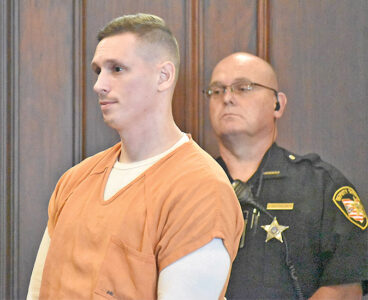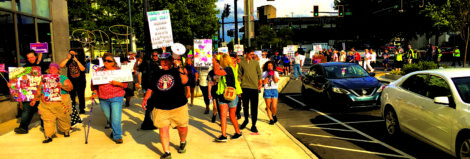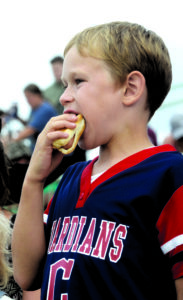Speed cameras in Youngstown school zones proposed
Presentation shows 21.3% speed in city
YOUNGSTOWN — A city council committee heard a presentation Thursday from traffic camera company Blue Line Solutions about reducing the amount of speeding in school zones with the use of stationary traffic cameras.
Blue Line regional sales manager Thomas Switick told the safety committee during a virtual meeting that the company set up cameras for a week in city school zones and found that 21.3 percent of the 188,000 vehicles checked were traveling at least 11 mph over the speed limit.
Eleven mph over is the speed at which the company would issue citations to the vehicle owner by mail. The company would operate the cameras, send out the citations and handle any followup, Switick said. The percentage of the revenue from the tickets would be determined in negotiations, but the contract the city had with another traffic camera company several years ago was 65 percent for the city and 35 percent for the company.
He broke down the numbers by telling the percentage of speeders in each of the seven wards of the city and ranking the various school zones by percentage of vehicles exceeding the speed limit.
It showed that the Kirkmere Elementary School zone on Kirk Road on the West Side had the highest number of speeders at 4,491 out of 8,141 cars (55.2 percent); Mahoning High School on Bryn Mahr Avenue on the East Side had the lowest number of speeders at 26 out of 1,166 vehicles (2.2 percent). The highest percentage of speeders is the East High School zone at 63 percent of the 4,116 vehicles.
The Kirkmere numbers hit home with Councilwoman Lauren McNally, who said the problem of speeding in school zones “is real, and it’s scary. I’m scared in the pickup line. I can’t imagine how the kids feel trying to walk out to the cars.”
She said, “Those statistics make me sick to my stomach. I knew we had a speeding problem in school zones. I’ve witnessed the speeding problem in school zones. I’ve sat on Schenley (Avenue) as my car shakes because the cars fly by and just to see (the statistics) on paper like that is disgusting.”
She said she is glad the police department is “trying to be proactive about really solving the speed in school zones.”
Councilwoman Anita Davis, a retired Youngstown police officer, said she remembers working in the Kirkmere school zone when she was a police officer. “It was a zoo back then,” Davis said.
The speeding in the Kirkmere area apparently is aggravated by the fact that it is a “known cut-through” area for many drivers, Switick said.
Lt. Bill Ross, head of the traffic division of the Youngstown Police Department, said the discussion with Blue Line followed “numerous complaints of cars speeding in school zones. We have had several officers from the traffic division out there working the road trying to curtail this.
“Unfortunately that did not have the impact we wished to have. We had just as many accidents and stuff from the month we had the officers out there as the month prior when we didn’t have officers out there,” he said.
“As a result of that, we had come in contact with Blue Line Solutions. They offered us a proposal through photo enforcement to curtail this problem before we actually have somebody hurt or killed in a school zone,” he said.
He said it would be up to the safety committee to decide what school zones would get the cameras. “You can put them in just the top five. You can put them in every school zone.”
The overall speeding percentages were similar in most of the wards — between 20 and 30 percent — but the first ward, which is in the downtown area, had only 13.7 percent.
Switick said installing traffic cameras or letting the public know that traffic cameras are coming typically reduces speeding by about 50 percent before any tickets have ever been sent, Switick said.
Police Chief Carl Davis told the committee that he has assigned three additional officers to work as community police officers so that there is now one community police officer for each ward.
Community police officers work to develop trust with residents in the neighborhoods, attend block watch meetings, keep in contact with the council member in that ward and help with issues such as zoning, litter, mental health and others, officials have said.
Ross said the last time the city had traffic cameras, it was through another company that outsourced its customer service functions, which he said were not effective.
SHOT SPOTTER
The safety committee also talked about whether it would be feasible to expand the ShotSpotter system that alerts the police department to gunfire on the South Side of the city.
The city has been using the system for about 10 years. It costs about $75,000 per year and covers an area of about three square miles.
If the company installed equipment to provide the service in the other parts of the city the cost would rise “exponentially,” Capt. Jason Simon told the committee.
Providing the system to three more sections of the city would cost $150,000 to $200,000 more per year per section, he said. On top of that, it would increase the cost of the existing service.
Councilman Jimmy Hughes, a former Youngstown police chief, said he supports the ShotSpotter system but he wishes the city had a video camera system “to bring the eyes to the perpetrators.”
erunyan@vindy.com




